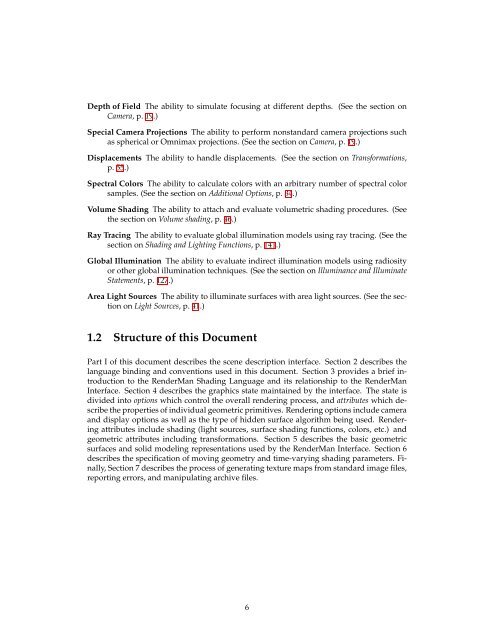The RenderMan Interface - Paul Bourke
The RenderMan Interface - Paul Bourke
The RenderMan Interface - Paul Bourke
- No tags were found...
Create successful ePaper yourself
Turn your PDF publications into a flip-book with our unique Google optimized e-Paper software.
Depth of Field <strong>The</strong> ability to simulate focusing at different depths. (See the section on<br />
Camera, p. 19.)<br />
Special Camera Projections <strong>The</strong> ability to perform nonstandard camera projections such<br />
as spherical or Omnimax projections. (See the section on Camera, p. 19.)<br />
Displacements <strong>The</strong> ability to handle displacements. (See the section on Transformations,<br />
p. 55.)<br />
Spectral Colors <strong>The</strong> ability to calculate colors with an arbitrary number of spectral color<br />
samples. (See the section on Additional Options, p. 34.)<br />
Volume Shading <strong>The</strong> ability to attach and evaluate volumetric shading procedures. (See<br />
the section on Volume shading, p. 46.)<br />
Ray Tracing <strong>The</strong> ability to evaluate global illumination models using ray tracing. (See the<br />
section on Shading and Lighting Functions, p. 141.)<br />
Global Illumination <strong>The</strong> ability to evaluate indirect illumination models using radiosity<br />
or other global illumination techniques. (See the section on Illuminance and Illuminate<br />
Statements, p. 127.)<br />
Area Light Sources <strong>The</strong> ability to illuminate surfaces with area light sources. (See the section<br />
on Light Sources, p. 41.)<br />
1.2 Structure of this Document<br />
Part I of this document describes the scene description interface. Section 2 describes the<br />
language binding and conventions used in this document. Section 3 provides a brief introduction<br />
to the <strong>RenderMan</strong> Shading Language and its relationship to the <strong>RenderMan</strong><br />
<strong>Interface</strong>. Section 4 describes the graphics state maintained by the interface. <strong>The</strong> state is<br />
divided into options which control the overall rendering process, and attributes which describe<br />
the properties of individual geometric primitives. Rendering options include camera<br />
and display options as well as the type of hidden surface algorithm being used. Rendering<br />
attributes include shading (light sources, surface shading functions, colors, etc.) and<br />
geometric attributes including transformations. Section 5 describes the basic geometric<br />
surfaces and solid modeling representations used by the <strong>RenderMan</strong> <strong>Interface</strong>. Section 6<br />
describes the specification of moving geometry and time-varying shading parameters. Finally,<br />
Section 7 describes the process of generating texture maps from standard image files,<br />
reporting errors, and manipulating archive files.<br />
6















